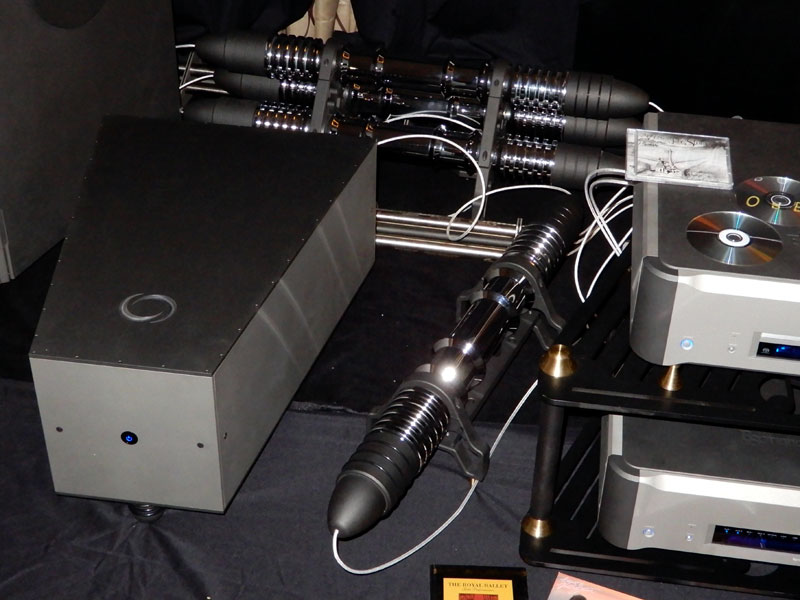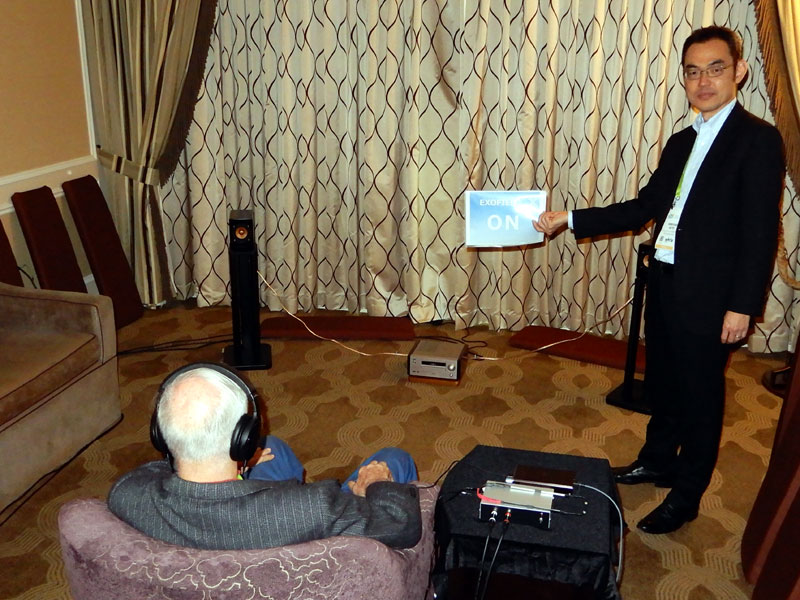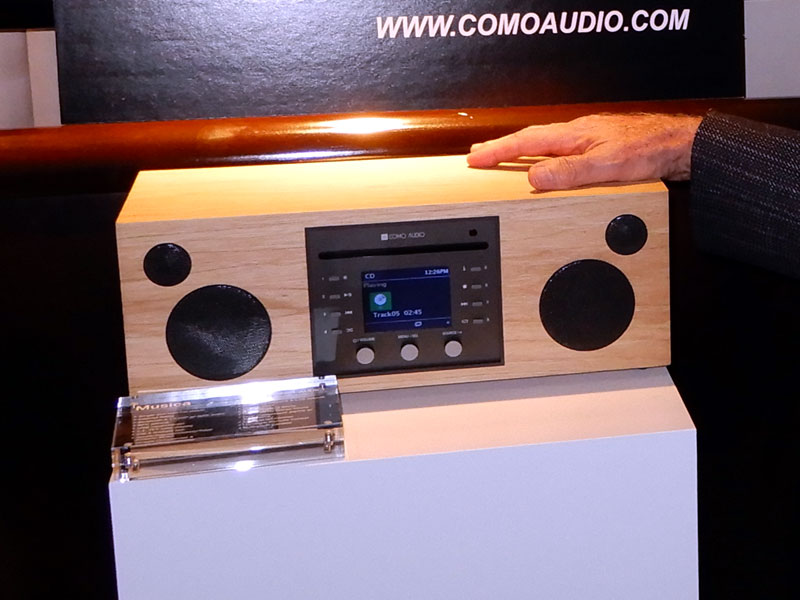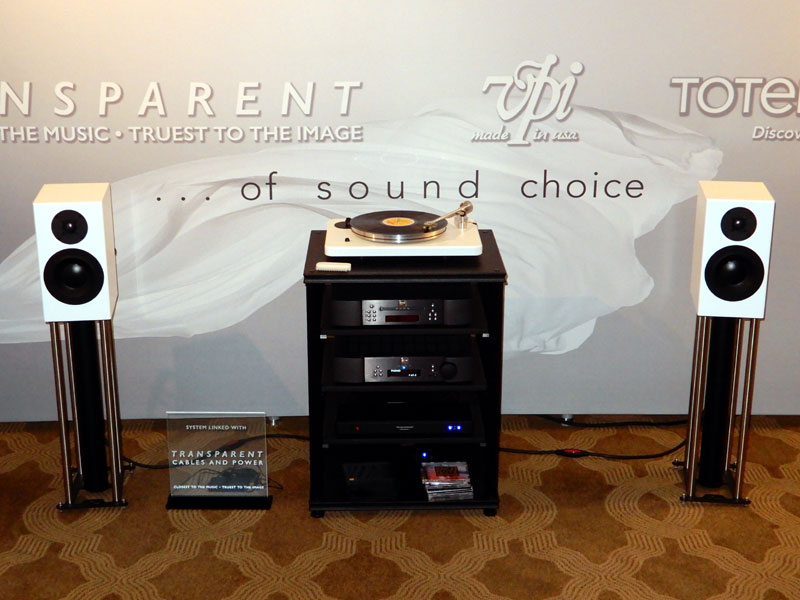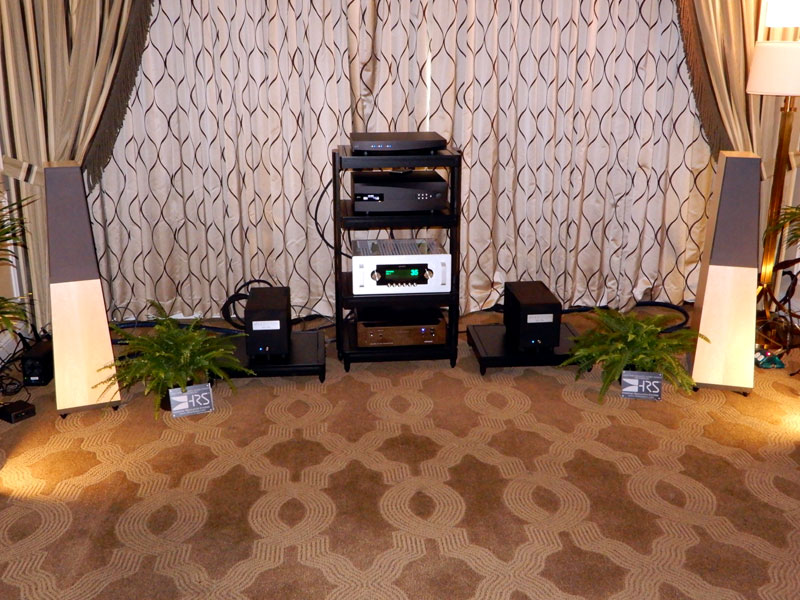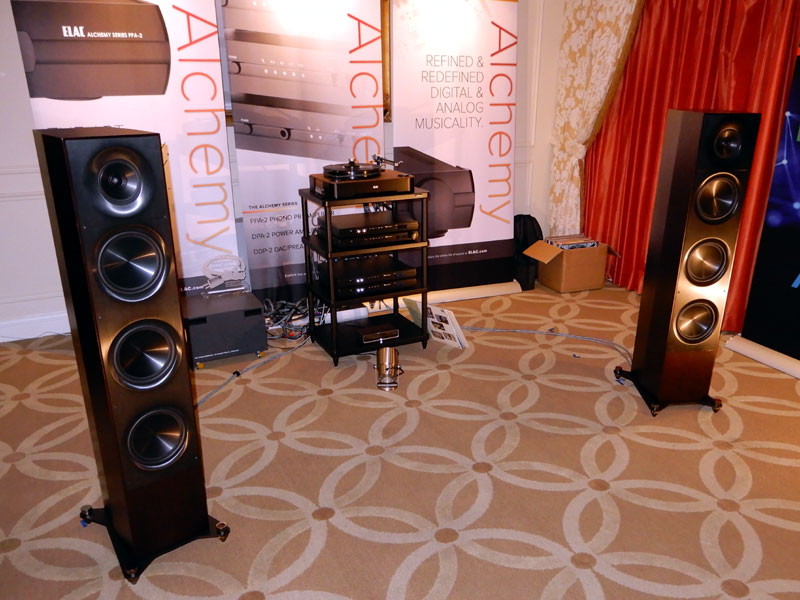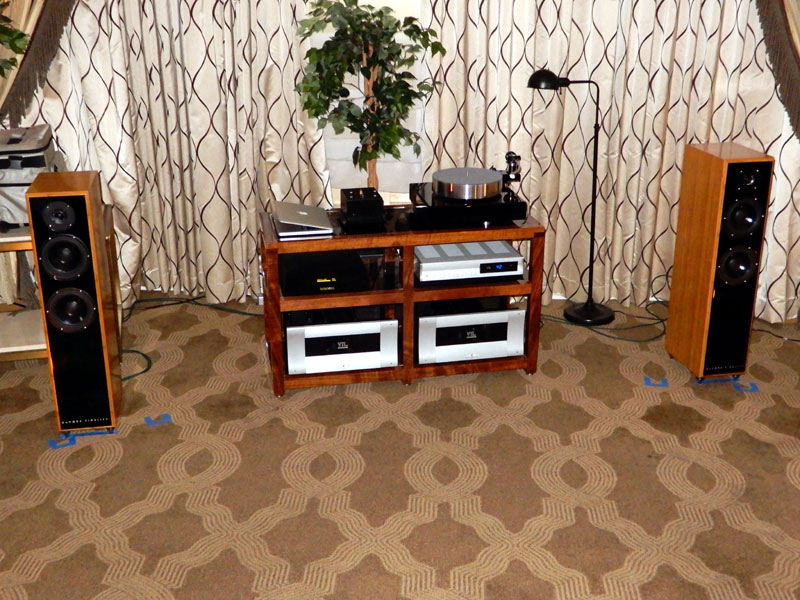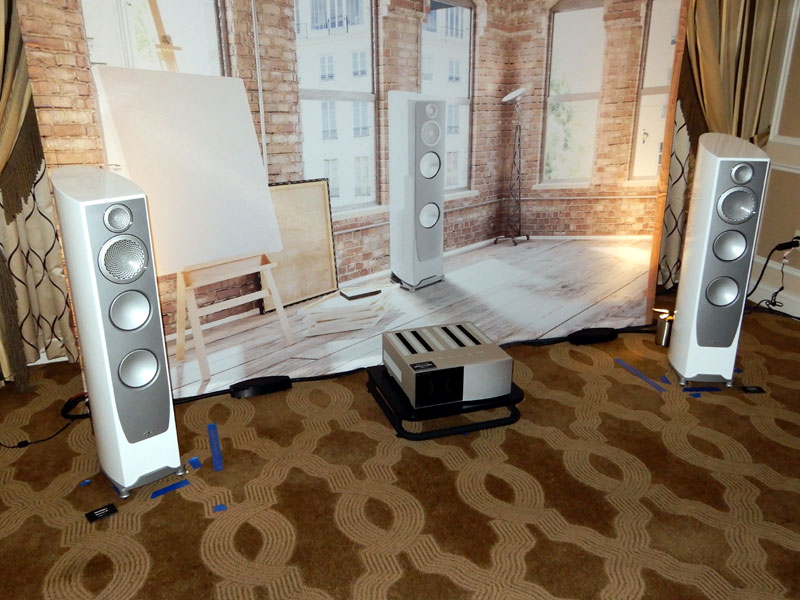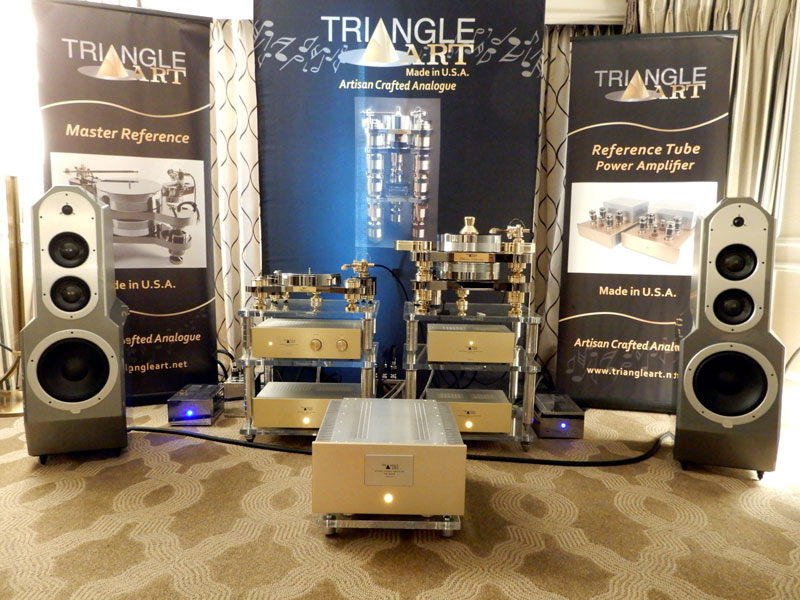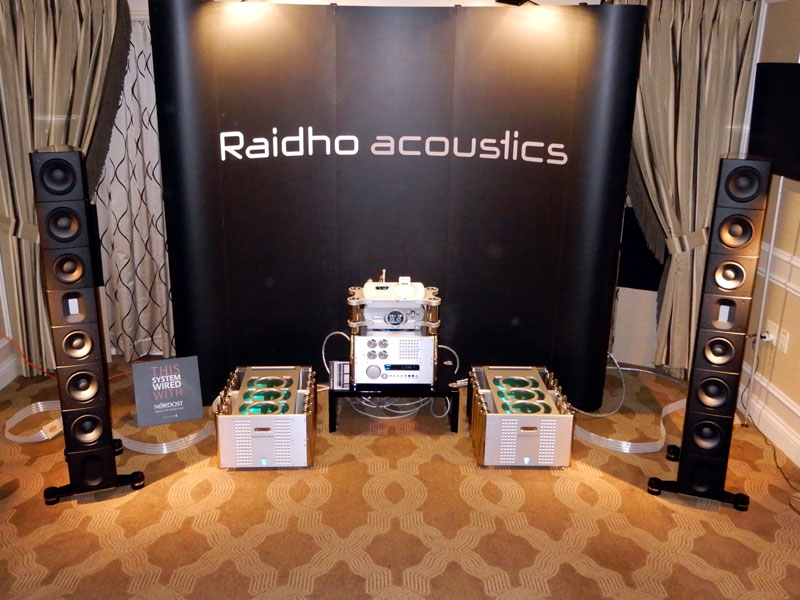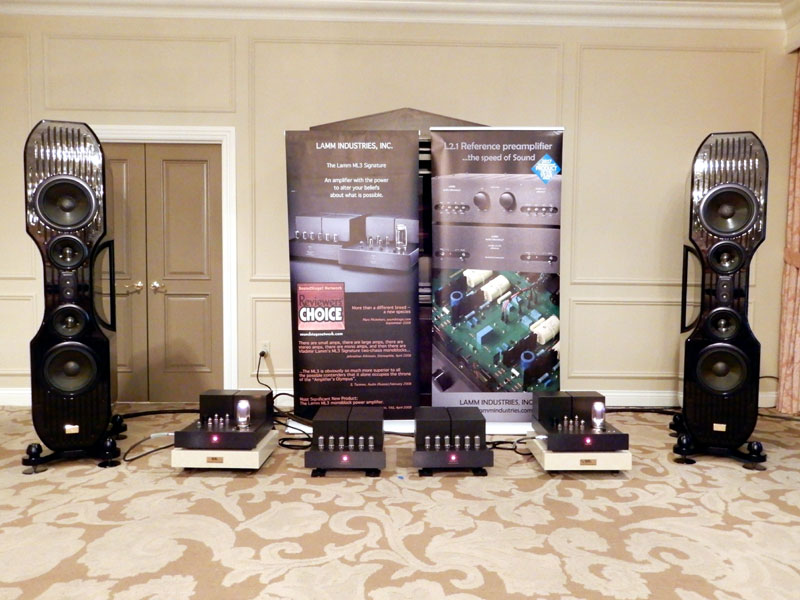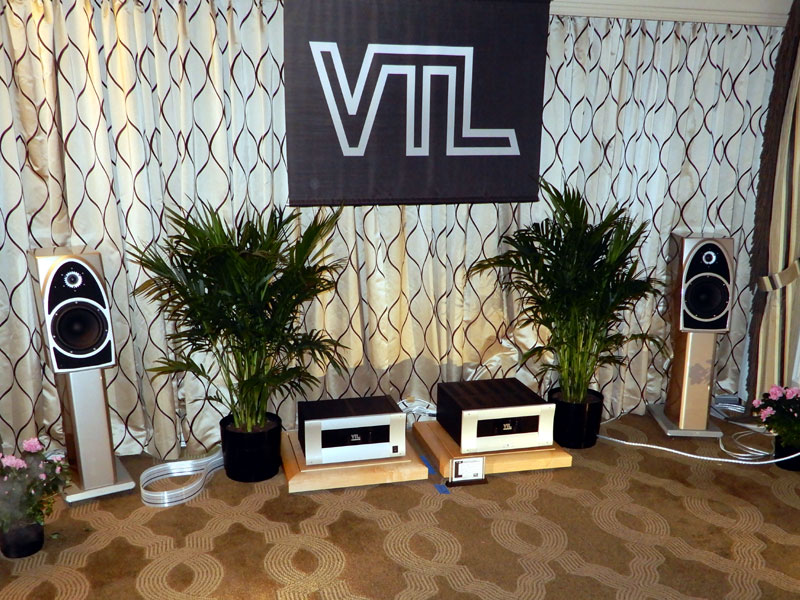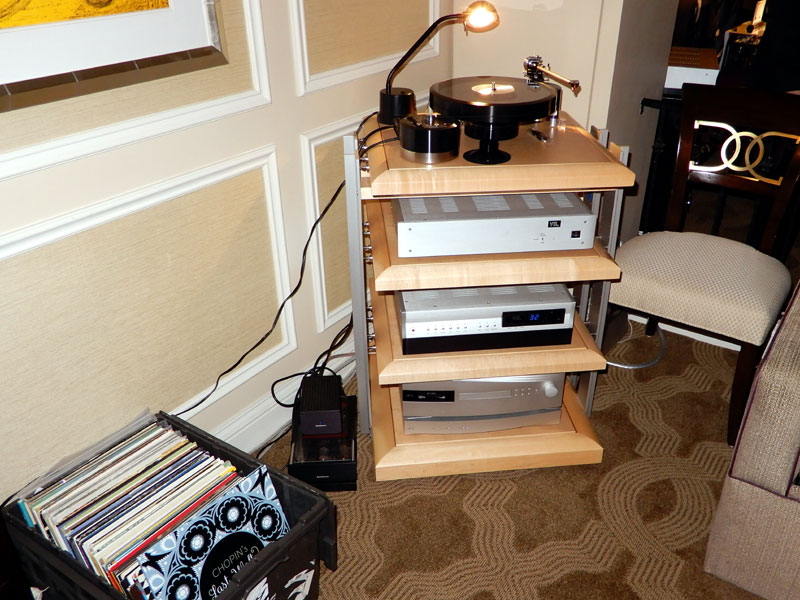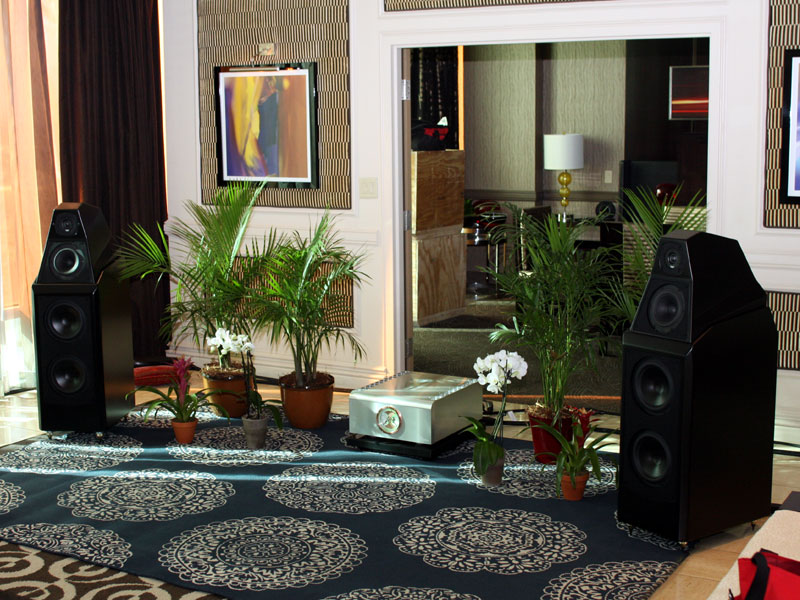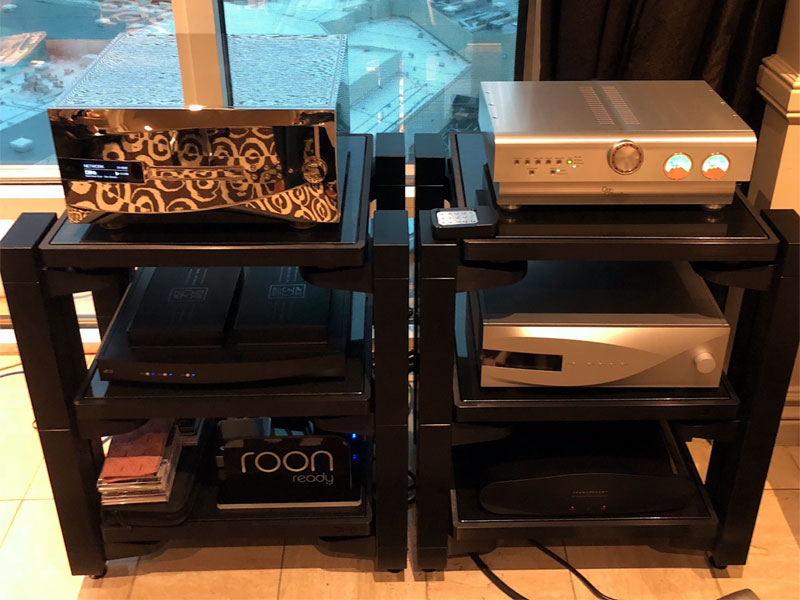Alive and . . . Well: The 2018 Jimmy Awards by Jim Saxon | February 8, 2017 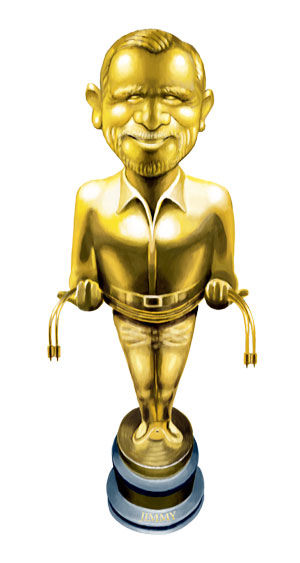 o paraphrase Mark Twain, early reports of the death of the high-performance-audio
exhibits at the 2018 CES were exaggerated. Indeed, the situation seemed dire at first. The
number of exhibitors was less than last year’s sorry showing. Tuesday, opening day,
saw displays on a single floor of the Venetian and parts of two other floors. As recently
as 2016, active systems appeared on five floors. Despite a record number of CES visitors,
attendees walking the halls of the Venetian early on seemed fewer than last year.
Nevertheless, those companies that bravely demonstrated components and loudspeakers did a
first-rate job of it. By Wednesday afternoon, the wake-like atmosphere was gone and the
walkways were crowded. Despite the sickly room count, the stalwarts who chose to attend
beckoned with high spirits and inviting sound. On Tuesday, I was concerned that the Jimmy
Award foray would have difficulty filling a report for The Audio Beat. Yet, by
Friday, I mentally began leaving outtakes on the cutting-room floor. Based on the ratio of
good sound to bad, 2018 may have hosted the best CES of all. o paraphrase Mark Twain, early reports of the death of the high-performance-audio
exhibits at the 2018 CES were exaggerated. Indeed, the situation seemed dire at first. The
number of exhibitors was less than last year’s sorry showing. Tuesday, opening day,
saw displays on a single floor of the Venetian and parts of two other floors. As recently
as 2016, active systems appeared on five floors. Despite a record number of CES visitors,
attendees walking the halls of the Venetian early on seemed fewer than last year.
Nevertheless, those companies that bravely demonstrated components and loudspeakers did a
first-rate job of it. By Wednesday afternoon, the wake-like atmosphere was gone and the
walkways were crowded. Despite the sickly room count, the stalwarts who chose to attend
beckoned with high spirits and inviting sound. On Tuesday, I was concerned that the Jimmy
Award foray would have difficulty filling a report for The Audio Beat. Yet, by
Friday, I mentally began leaving outtakes on the cutting-room floor. Based on the ratio of
good sound to bad, 2018 may have hosted the best CES of all.
A satisfying reacquaintance Years ago, I owned a truncated tower loudspeaker, the Genesis Advanced Technologies G500, designed by the late Arnie Nudell. After Mr. Nudell sold the company in 2006, I assumed that a new owner would lose the vision of the company’s founder. Wrong again, Jim. After listening to the new Genesis Maestro ($30,000/pair in dazzling rosewood), I realize that Genesis’s owner and designer, Gary Koh, has not merely refined an exceptional loudspeaker but has reengineered it to a high standard. The Maestro’s 500-watt servo-controlled bass amplifier drove four 8" low-frequency drivers with marginal distortion. According to Mr. Koh, "the world’s best tweeter," a ribbon in circular form called a ring radiator, enables a linear response in the "lower frequencies." Such a claim may explain why the tweeter didn’t tweet by its lonesome but blended seamlessly with the midrange. For listening rooms with hard surfaces, the Maestro has an adjustable high-frequency control for taming glare. The tweeter can also be flipped up to excite overly damped rooms. Why doesn’t every high-end loudspeaker offer such flexibility? The Maestro was driven by a pre-release Viola Audio Laboratories Chorale solid-state integrated amplifier (125Wpc at an estimated $19,000). The Chorale’s remote control operates via IOS or Android applications. A USB master input for software updates is included. Genesis’ own Gold phono stage ($8000) amplified the analog signal from a VPI Vanquish turntable with Fat Boy tonearm ($40,000 for both pieces) and Transfiguration Proteus D cartridge ($10,500). Genesis Absolute Fidelity cables and racks (price available on request) fitted out the system. For taking a hallowed design and making it better, Genesis Advanced Technologies receives the first Jimmy Award of 2018.
Magnetic signal repair Congratulations to High Fidelity Cables (HFC) for acquiring such an obvious yet unprotected company name. On the other hand, given their breakthrough technology, I think Magnetic Magic would more aptly fill the marquee. Company founder Rick Shulz conducted a mesmerizing show-and-tell of how alternating current affects a signal. According to Shulz, unguided AC scatters electrons around the inside of a conductor, causing them to arrive disorderly and mistimed at their destination. Such unsupervised transmission produces distortion. However, using magnets to funnel electrons from wall outlet to transducer propagates a more precise musical waveform. The company’s motto is "Our cables are magnets." Since Shulz also recognizes the problem of undisciplined electron transmission within electronic devices, High Fidelity Cables is working on magnets for use in component circuitry as well. Perhaps, one day we’ll see the motto "Our amps are magnets." Of the products on display, the most visually impressive was the top-of-the-line Pro Elite Helix AC cable (price to be announced, but more than $23,000 for two meters!). Housed in metal modules thicker than Popeye’s forearms, they resemble giant ant pods from the sci-fi thriller Them! Upon request, the HFC team played a CD through about $75,000 worth of magnetic wires. I was underwhelmed. Apparently, my ear is used to hearing more signal than exists at the source -- i.e., added distortion. After a few minutes of listening to the magnets at work, however, I became aware of exquisite microdynamics. Eventually I began to sing along, a telltale sign that I was enjoying the macrodynamics as well. Signal-riding noise may seem as though it adds amplitude when all it does is create listener fatigue by forcing the brain to filter it out. One of the reasons I love amplifiers that use the KT150 vacuum tube is that my mind relaxes in the absence of ringing, thanks to the tube’s oval shape. But I digress. High Fidelity Cable’s technology threatens manufacturers who use filters or geometry to lower distortion. The company also competes by offering cables for almost every budget, as well as accepting their used products in trade toward the purchase of upgrades. Challenging long-held notions, High Fidelity Cable wins a Jimmy Award for producing an original design that "was not obvious to experts in the field" (the main criterion for registering a patent).
Seeing and believing Although JVCKenwood had no product to show, they merit recognition for an ingenious development. A company press release promised that their Exofield headphone technology would impress, and it did. JVCKenwood has designed a personal fit-to-match listening code that enables any headphone brand to deliver a thrilling psycho-acoustic experience. Exofield takes the sound out from between the ears and projects it forward by about eight feet, as if listening to a pair of loudspeakers at that distance. The process requires taking measurements of an individual’s hearing parameters and recording them to enhance playback through headphones of any make. The result is unobtrusive personal listening without a mild feeling of claustrophobia. Although acoustically mapping each wearer through in-ear measurements may be a chore at first, eventually engineers will streamline the process. Once headphone users hear the impossible, I doubt they will ever yearn for traditional in-head imaging. For bringing a third dimension to the headphone experience, JVCKenwood lands a holographic Jimmy Award.
New wine in "old" bottles Boston-based Como Audio showed a line of retro-looking high-tech radios. Because of their warm sound, I’d be happy to buy one any day, yet the four models go far beyond radio transmission. They can play music from Spotify, Tidal, Napster, and Deezer plus Internet radio, Bluetooth, CD player, FM radio and more. Even better, they can be used in multiple units to provide music to every room in the house. A Como application converts smart devices into wireless touchscreen tools. For those who prefer to push buttons, there is also a remote control. The idea of having the same background music around the house is appealing. It negates the need for distorting volume in the den in order to hear music in the living room. For providing a multi-room audio experience that both cleaning ladies and work-at-home executives would love, Como Audio merits a streaming Jimmy Award.
High-end sound for tiny homes If audiophiles ever join the trend toward downsizing houses, Totem Acoustic will have the perfect ultra-high-fidelity loudspeaker to fit the venue. The Totem Signature One ($2650/pair with optional 24" stands at $500/pair) is a minimonitor for the ages. Although it measures 14" x 8" x 11", the Signature One can reach 45Hz at a mere -3dB without noticeably compressing. This physics-defying feat is accomplished by lock-bracing the rigid cabinet, utilizing borosilicate damping, fine-tuning proprietary crossover technology and employing an unflappable low-frequency driver. As a result, the speaker competes with all comers. Besides offering tonal balance and texture, the Signature One is an imaging champion. I "watched" the music as much as listened to it. For those who belittle imaging as being non-measurable and therefore nonexistent, I say your brain has a blind spot. In order to compete with the big boys of audio, Totem relied on an organic-sounding Simaudio Moon 240i integrated amplifier with phono stage (50Wpc, $2100), a VPI Cliffwood turntable with Grado Green MM cartridge ($895!) and a raft of Transparent Audio cables, including a Hardwired power cord ($75), MusicLink phono interconnect ($250), MusicWave speaker cables ($440/eight-foot pair), and a PowerBank 6 power conditioner ($695). The total cost of the entire display was a manageable $7105, ensuring Totem Acoustic a Jimmy Award for Best Value System at the Show. Before moving on, I would like to recognize the long-term efforts of Totem Acoustic’s brain trust, Vince Bruzzese. He began building loudspeakers in 1988 and continues to fine-tune with his original gusto. At show after show, using different electronics and cables, Totem has produced gratifying sound. In terms of money earned, Bruzzese may have missed a fortune by designing monitors instead of floorstanding flagships, but he has done well. After years of butting heads with the biggest and best, Vince Bruzzese joins the living legends of high-end audio. On the occasion of Totem Acoustic’s 30th anniversary, the Jimmy Awards recognizes Mr. Bruzzese for devoting his career to the pursuit of musical enjoyment, even now embarking on a second generation of excellence.
Amplifier innovation -- again Speaking of legends, Richard Vandersteen of Vandersteen Audio unveiled a pre-production mono amplifier at the show, the M5-HPA (150 watts into 8 ohms, $15,000/pair). Derived from Vandersteen’s highly regarded M7-HPA ($57,000/pair), the new monoblocks are a rare bargain. In powering the passive drivers in Vandersteen’s Quatro CT loudspeakers ($14,600/pair), which house active subwoofers, the M5-HPA blended midrange and upper bass with nary a hint of the discontinuity that often plagues a subwoofer-satellite system. Although audiophiles eschew powered speakers, the Quatro CT mated to the M5-HPA deserves a listen by anyone seeking a major upgrade to his system. The amplifier’s range of adjustable high-pass filters from 20Hz to 200Hz enables hands-on owners a modicum of control. Although the sound pressure level in the room was lower than I like, nevertheless I had another Vandersteen room epiphany brought on by Frank Sinatra’s poignant rendition of "Where Are You." Rather than a tale of alienation, I heard the song as referring to the death of a loved one. This flight of imagination was aided by a dCS Rossini CD player ($28,499) and master clock ($7500). The sonically transparent Audio Research Reference 6 preamplifier ($14,000) also figured largely, along with AudioQuest Wild interconnects and speaker cables (approximately $26,000), Wild digital cable ($7300), Wild power cords (approximately $10,500), Niagara 7000 power conditioner ($7995), and Harmonic Resolution System RXR audio stand system ($7295) with RXR amplifier stands ($3750/pair). In honor of ongoing innovation in the speaker/amplifier interface, Vandersteen Audio garners their umpteenth consecutive Jimmy Award.
Along Came Jones meets The Alchemist In the Elac room, I was surprised to find an old industry friend, Peter Madnick, the alchemist behind Audio Alchemy (AA) of yore. Renamed simply Alchemy, AA is now a division of the venerable loudspeaker manufacturer Elac, whose newest models are the work of former KEF and Pioneer/TAD designer Andrew Jones. Jones and Madnick have created a product synergy that produced one of the best sounds at the CES -- among the top five, really. Elac’s Adante AF-61 floorstanding speaker ($5000/pair) driven by Alchemy electronics was a revelation. Listening to the catchy but politically incorrect tune "Cousin Dupree" gave me chills. Who but Steely Dan has the savoir faire to carry off a song featuring incest, sexual fantasy, and freeloading? The Elac-Alchemy system captured the jarring dichotomy between an upbeat arrangement and sinister street-smart lyrics. A less confident presenter might have chosen the sonic safety of Patricia Barber or Diana Krall, but not Elac. For the record, Alchemy used a pair of DPA-2 hybrid analog/class-D stereo amplifiers (650 watts wired for mono, $1499 each), and a DDP-2 preamp/DAC with streamer ($2499). The DAC section has DSD as well as PCM capability and can be used with Spotify, Bluetooth, Airplay and Roon among other options. Cables were made to order by Tim Marutani (price to be determined). For blending cutting-edge electronics with state-of-the-art loudspeakers at an eminently affordable price, Elac and Alchemy deserve a double Jimmy Award.
Brooklyn’s finest The DeVore Fidelity room is an annual must-visit thanks to my deep admiration for David versus Goliath. This year, John DeVore, the wizard behind the curtain, played a riveting voice-and-piano selection that eluded my ken. At first, I tried to identify a soprano, then a male falsetto, and then I gave up. The artist was Prince. The song was "One Night Alone," released in 2002. The spare arrangement was like listening to a voice from beyond the grave. As a result, the DeVore system, featuring their Gibbon Super Nine loudspeakers with paper woofers ($9900/pair) immediately won a Jimmy Award for eeriness at the CES. Helping the cause were several brilliant products, including VTL MB-185 Series III Signature mono amps (140 watts in triode, $20,000/pair) and VTL TL-5.5 Series II Signature preamplifier with internal phono ($11,000). The digital music source was a Totaldac d1-tube-mk2 DAC ($11,000), which warrants further investigation. In other words, spending $40,000 on electronics and $10,000 on loudspeakers is a Jimmy Award-winning formula, providing the speakers are of DeVore quality and the amplifier is a tube amp, preferably VTL. The components were housed in a Box Furniture Co HD3 Custom Claro rack ($9000 -- a good rack is worth the money.) Economizing on cables, DeVore used Auditorium 23 interconnects ($795 per meter pair) and speaker cables ($980 per 2.5-meter pair). Maybe John DeVore should call Rick Shulz at High Fidelity Cables and give the magnet wires a try. A new classic The famous KLH Model 9 electrostatic loudspeaker is alive and well and living in Noblesville, Indiana. There, the new owner of KLH Audio, David Kelley, a longtime member of the hi-fi industry, lives and works. The venerable, majestic flat-panel Model 9 ($24,998/pair) was on silent display when I entered the room. Instead, a pair of conventional floorstanders flanked the Model 9. Since they were hooked up, ready to go, I figured they must be pretty good. From the first beat of Rebecca Pidgeon’s haunting version of "Spanish Harlem" to the last heart-wrenching note of Joss Stone’s "The Chokin’ Kind," the new Kendall ($1290/pair in real wood veneer) held me in thrall. Impressed, I asked Kelley if he planned to build a larger version of the Kendall. His reply was, "This is the larger version." Astonishingly, the Kendall has two smaller siblings at even lower cost, but never mind. As a starter high-end loudspeaker set, the Kendall is it. Motivating four drivers per side was a ruby-red amplifier from Rogers High Fidelity, the EHF-200 Mk II (200Wpc with KT150 tubes, $15,900). CD playback was via a used Pioneer Elite PD-75 CD player ($1200 in 2009). Although price-wise a mismatch, the pairing of KLH Kendall and Rogers tubes was celestial. To my ear, the egg-shaped KT150 has clarity equaling that of single-ended triodes, yet with enormous power when paired in push-pull configuration. I don’t know why every tube-gear designer doesn’t clean-sheet an amplifier using the KT150. If I had $17,000 to spend on a system, I’d allocate 75% to the Rogers EHF-200 Mk II amplifier and the rest to the KLH Kendall. For showing how wonderful $1300 speakers can sound, KLH and Rogers capture a Jimmy Award.
Look who’s coming to dinner For thirty years Canadian loudspeaker manufacturer Paradigm has provided a bold, if somewhat colored to my ears, listening experience. This year they crashed the high-end buffet with their new Persona 3F floorstanders ($10,000/pair). Driven by electronics from Paradigm’s Anthem brand (STR preamplifier, $3999, and STR power amplifier, $5999), the Persona 3F sounded subtle and refined, a departure from the party-on-Paradigm manner. Although Paradigm and Anthem are synergistically matched for use in smart-home installations (their room-correction software really works!), these new products compete with the best among high-end separates. High-resolution audio files have seldom sounded better than in the Paradigm room. For successfully invading mogul territory, Paradigm carries off a Jimmy Award.
Artisan-crafted analog Triangle Art is aptly named. The Anaheim, California-based company produces some of the most aesthetically pleasing components in the known universe. Company rep Tom Vu brought Triangle Art’s entire catalogue of shimmering products to the show, including the Master Reference turntable ($39,900) with Osiris Mk 2 12" tonearm ($6800) and Apollo MC cartridge ($8000), along with the Reference tube preamplifier ($17,998), Reference tube phono stage ($12,998) and Reference mono amplifiers (160 watts, $35,996/pair). As if that weren’t enough, Triangle Art also produces cables, including the RHEA Reference interconnect ($2890/meter pair), power cord ($2890) and speaker cables ($4990/eight-foot pair). Triangle Art shared the room with Memphis-based Egglestonworks, whose Andra III loudspeakers ($25,500/pair) sounded harmonious. It may be worth noting that Egglestonworks loaned products to three electronics manufacturers at the CES. Of the three demos, two rooms featuring the redesigned Andra III outperformed (except in bass) the room where Egglestonworks’ new and much costlier Viginti was playing. The Andra III systems featured tube gear, while the Viginti demo used a solid-state amplifier of renown. Could there be a connection? Based on the Jimmy Awards’ infallible ear test, Triangle Art edges Increcable (see below) for best-sounding room using Egglestonworks speakers at the CES. Increcable is incredible. Get it? The second award-winning demonstration featuring Egglestonworks Andra III speakers was in the Increcable Acoustic Lab room. As I entered, Aaron Neville’s quavering tenor was inspiriting the song "Angola Bound" in all its rhythmic pathos. The next track was The Nylons covering the Beatles’ "Because." The a capella group emerged from a black background, voices suspended in midair with dimensionality and timbre. If high-end audio is about connecting with the music, Increcable’s demo met the standard. As the name suggests, Increcable is a cable manufacturer that now builds tube gear. In a contracting hi-fi market, vertical integration may be a means of survival. Apart from the digital source -- a laptop hooked up to a discontinued Furutech headphone amp/DAC ($300), Increcable supplied their TPC-1HP preamp ($6000) and TPA-280 amp with KT150 tubes (100Wpc, $9000). AC cabling was the Increcable Lava eXtreme ($800/1.68-meter length); interconnects, the Terra T-2 ($600/1.5-meter pair); and speaker cables, the Basso ($800/1.68-meter pair), along with a J2 speaker jumpers ($600/pair). Increcable also displayed three other intriguing products: the IPC-6GB, a bronze-plated power conditioner with grounding function ($1250); the IEH-2, a matching wall plate ($180); and the Volcano eXtreme, a power cord from wall outlet to conditioner ($2000/2.5-meter length). Increcable’s export manager, Dyson Lai of Bensalem, Pennsylvania, also demoed a damping device called the MVD-2 ($180/set of four) that had a benign effect when mounted on vibrating surfaces such as transformers and loudspeakers. For tweaking the daylights out of their system to salubrious effect, Increcable joins the list of Jimmy Award winners for 2018.
Four characters in search of a distributor Over the years, France has produced some famous names such as Cabasse, Focal, and Jadis, as well as some not so famous -- at least not in the US. Such is the case of the companies huddled in the Esprit Audio room. There, Esprit, maker of cables for every budget, shared the spotlight with French manufacturers Davis Acoustics and Totaldac, plus a new amplifier company, SAG (Simon Audio Group) from Seoul, South Korea. This exotic foursome produced well-balanced sound free of the glare that inexperienced companies tend to achieve in hotel rooms. Ah, but Esprit and Davis are hardly inexperienced. Esprit has been in business for fifteen years and Davis over thirty! Yet, to my knowledge, neither company has US distribution. The Davis Nikita model, a shiny ebony two-way scheduled for mid-March release ($7500/pair with stands), had an ineffable rightness that one instantly recognizes as high end. Esprit’s Eureka speaker cables ($9800/two-meter pair), as well as their Aura AC cable ($800/1.8-meter length) and Eterna USB ($800/1.2-meter length) pass the eye test. The SAG P3 preamp ($6000) and S3 power amplifier (150Wpc, $5000) use discrete circuits, a trait shared with many costlier makes. The real sleeper here may be the Totaldac Model 7 ($19,000). Although it seems fully priced, the lonely genius who created Totaldac fifteen years ago has to eat too. The online photo of founder Vincent Brient suggests a driven perfectionist. Great hi-fi companies have begun with such personalities. Although I haven’t seen a picture of Simon Lee of SAG, Olivier Visan of Davis Acoustics says he’s in the same extremist club as M. Brien. For the most promising system without US distribution, the Esprit/Davis Acoustic/Totaldac/SAG room is cited for a We Try Harder Jimmy Award. Bespoke loudspeakers When I first encountered California Audio Technology (CAT) a decade ago, I couldn’t quite understand the company’s mission. Did CAT sell products or were they consultants? This year, company president Brian Barr explained that they did both by building loudspeakers on a made-to-order basis. Given the massive, heavy-duty construction of their products, I can see how they would survive in recording studios, on yachts and in airplanes without costly downtime. Anyone who has difficulty taming his listening environment should contact CAT about custom-ordering loudspeakers to meet the challenge. Although bespoke speakers come at a price, that they are even available is a minor miracle in an era of one size fits all. For catering to frustrated fanatics on varying budgets, CAT earns a Jimmy Award.
Planar-magnetic tweeter and diamond drivers Prior to the CES, I thought that the world’s only planar-magnetic speaker came from a company near Minneapolis, Minnesota. However, Rune Skov, the high-energy sales director at Raidho Acoustics of Denmark, assured me that all Raidho loudspeakers use a planar-magnetic ribbon tweeter. Thus, the term Magneplanar describes a technology and not a patented product. Fascinating. However, the ribbon tweeter is hardly the tail that wags the Raidho dog. The model D-4.1 (in striking walnut burl, $105,000/pair) incorporates two 100mm diamond midrange drivers and four 115mm diamond woofers. Mounted as a line array within a slender 1555mm tower, the seven drivers were dynamic, of a single sonic fabric, and cast a wide sweet spot. Mr. Skov played an engrossing CD: Shostakovich Violin Concerto No.1 in A minor op. 99, the "Passacaglia" from the recording Echoes of Time by Georgian violinist Lisa Batiashvili. The menacing bass notes underlying the violin’s lyrical lament provided an unrelieved tension over most of the track’s fifteen minutes -- for a Patricia Barber lover, an eternity. Yet, if one is going to invest a quarter of a million dollars in a stereo system, he should stock up on some serious music. Sharing the room with Raidho were objets d’art from Chord Electronics, including the Dave 2 Reference DAC, headphone amplifier and preamplifier ($11,288), Blu Mk II upscaling CD transport ($10,588), CPA 8000 preamplifier ($45,000), SPM 1400 MK II amplifier (mono, 480 watts, $86,000/pair) and an Ensemble stand for the Dave and Blu ($1895). Tying all the Chords together were Nordost Valhalla 2 cables. For visual as well as aural gratification, Raidho and Chord both merit Jimmy Awards.
A costly near miss Logically, the best sound at the show had to be the Lamm Industries exhibit, where a proven system with a $649,000 price tag was playing. In fact, two years ago, I considered the Lamm room a runaway winner. Yet last year, and again in 2018, I felt something was awry. The breath of life was missing. Revisiting my report from 2016, I see that the electronics and loudspeakers are the same. The turntable this year is twice as expensive and the cartridge is half the price of the product used in 2016 -- a push, perhaps? The big difference is that the cables have changed. For the past two years, Lamm has used Tchernov Cable instead of Kubala-Sosna. I suspect therein lies the problem. Nevertheless, Lamm definitely had one of the best demonstrations at the CES, just not the best. For those who relish dollar signs, here’s a list of products used: Lamm ML3 Signature mono amplifiers ($139,690/pair), LL1.1 Signature line-level preamplifier ($45,590), LP1 Signature phono stage ($36,890), Kharma Exquisite Midi Grand Signature speakers, ($191,000/pair), a TechDAS Airforce 1 turntable ($110,000), and SME 3012 tonearm (long out of production), an Ortofon Winfield Ti cartridge ($4390), Aqua La Diva CD transport ($9000), Acoustic Formula xHD DAC ($16,500), Sanus Euro Series racks ($1040 total), Silent Running Audio amplifier stands ($1600 each), along with Tchernov Cable Ultimate interconnects, speaker cables, AES/EBU cable and power cords ($74,750 total). The Lamm Industries room gains a Jimmy Award for sharing in high style their 25th anniversary.
Bulls-eye analog VTL demoed an analog system featuring their "budget" product, the TP-2.5i phono stage ($3750). The great sound suggests that little brother is nearly as revealing as its pricier sibling, the TP-6.5 Signature phono stage ($18,000). A look inside the compact TP-2.5i shows a third as many parts as contained in the TP-6.5 Signature. Could this be proof that in phono-stage design, at least, less is more? For upstaging their own cost-no-object product, Luke Manley, the technical wizard at VTL, and Bea Lam, the golden ear, together merit a Tell It Like It Is Jimmy Award.
Meanwhile, VTL, the company, earns a JA for the Best Analog Sound at the Show. Their system reproduced a young Frank Sinatra’s light baritone with even better timbre than Vandersteen’s digital array did -- no mean feat. Besides the TP-2.5i, the VTL system consisted of an S-200 Signature stereo amplifier (200Wpc, $12,500), a Brinkmann Spyder turntable (including 10.5" tonearm, $17,490) with RöNt power supply ($4190) and Lyra Etna cartridge ($8995). Nordost cables included Odin 2 power cords, interconnects, and speaker cable, as well as a Nordost QRT QB8 Mk II power conditioner ($1599). Placed flush against the room’s front wall, a pair of Wilson Audio’s Duette Series 2 speakers ($22,500/pair) sounded as full-range as stand-mounted monitors can. Together, VTL, Wilson, and Nordost outperformed systems costing five times more.
Bulls-eye digital The best digital sound at the CES wasn’t found at the show but rather in a luxury suite at the Mirage, where British manufacturer dCS, under the supervision of Boston-based John Quick, revealed their limited-edition single-box CD/SACD player, the Vivaldi One ($80,000 in standard finish) paired with a Rossini clock ($7500). A single-chassis (without clock) alternative to the three-box Vivaldi 2.0 system, the Vivaldi One uses the latest version of the dCS Ring DAC, suggesting that although it’s a third the size of the Vivaldi 2.0, the newer One may outshine its older, more elaborate predecessor. Certainly, the dCS system sounded at least as realistic as last year’s, which featured the Vivaldi and Wilson Alexx loudspeakers. The Roon-ready One enabled Mr. Quick to access local files with barely any spool-up time. His first selection, "Relatively Easy," from Jason Isbell’s sterling album Southeastern, captured my attention by mentioning Klonopin (clonazepam), a treatment for panic disorder to which a loved one of mine is addicted. From that moment, I became a highly suggestible critic. Every tune Mr. Quick played seemed to have relevance to my situation. The climax was provided by a track from the CD-R compilation that TAB editor Marc Mickelson brought to the shootout. Greg Brown’s "Shake Sugaree" lists the total of low-value assets the singer was forced to pawn, a predicament facing many of us in this era of sudden economic change. Ironically, this tale of economic as well as emotional woe was portrayed on a stereo system worth the price of a three-bedroom house. We audiophiles range across a wide spectrum.
The Vivaldi One’s performance was amplified by the liquid-sounding D’Agostino Master Audio Systems Progression preamplifier ($22,000) and stereo amplifier (300Wpc $22,000). Front-end electronics were ensconced in an HRS VXR equipment rack, ($22,950). The cabling by Transparent Audio consisted of their Generation 5 XL power, analog, speaker and Ethernet cables (approximately $50,000). A Transparent Reference PowerIsolator ($5995) was used on the Vivaldi One and Progression preamp. The fourth and perhaps most intriguing element in the award-winning system was a pair of Wilson Sasha 2 loudspeakers decked out in satin black paint ($33,950/pair). Although I thought the Wilson Alexx ($109,000/pair) approached perfection at last year’s show, I surmise that the Sasha 2 reproduces 90% of the Alexx experience for a third of the cost. For advancing the digital state of the art yet again, as well as taking great pains over system selection and setup, dCS deserves an Imperial Jimmy Award.
Postscript If, as some believe, 2018 has seen the
last of high-end audio at the CES, I would like to say thank you to the firms that trekked
to Las Vegas for this and every outing since the late ‘90s, when I first began
attending. Otherwise, the Jimmy Awards would never have existed. I am also most grateful
to TAB editor Marc Mickelson for supporting my work over many years. It has been
quite a run. |

